
Introduction to Inbound Marketing
Depending on who you ask, there are lots of definitions for inbound marketing. That said, there are two predominant types of definitions that we shall highlight below before we can dig deeper into how inbound can lead your company to new heights.
The first type of definition essentially describes it as the opposite of outbound marketing. Outbound marketing is basically traditional advertising where you find a way of interrupting your potential customer, to get them to buy something. Outbound methods include fliers, direct mail, radio/TV/print ads, telemarketing, cold calling, etc. It follows then that the opposite of outbound marketing, (inbound marketing), is instead about attracting an audience to your brand.
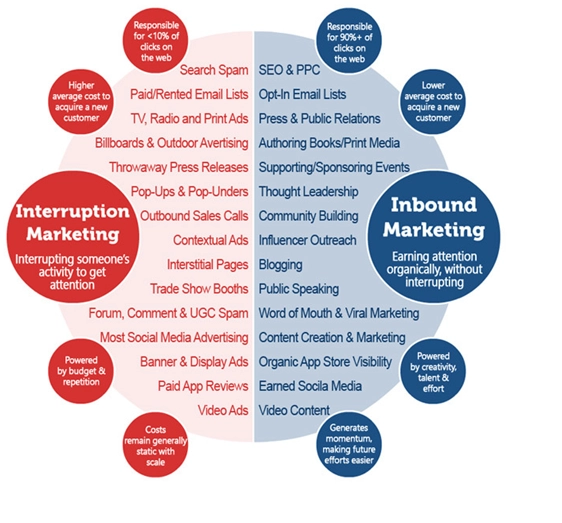
Figure 1: Inbound Marketing vs. Outbound Marketing
The second type of definition cuts straight to the chase. Inbound Marketing attracts strangers and funnels them through the sales cycle. It entails the following fundamental steps:
- Attract (A stranger becomes a website visitor): Put your brand in front of prospects looking for what you have to offer, and give them useful and engaging content that will help them solve their need or desire, for free. Important tools used at this stage include Inbound content, SEO, blogging and social media marketing.
- Convert (A visitor becomes a lead) : The next step is to entice the visitor to submit their contact details so that they can join your sales or marketing funnel. The way to do this is to give the visitor a compelling reason to provide their contact information. For example, offer them premium content like eBooks, checklists, etc. for free. Popular tools at this stage include Landing Pages, Forms, Calls-To-Action and Dynamic Content. If the visitor provides their contact information, they are now a lead.
- Close (A lead becomes a customer): Once you have qualified website visitors and leads, you then want to ensure that they buy what you have to offer and become customers. Some of the tools that will help at this stage include Marketing Automation and Workflows, List Segmentation, Email Marketing and Sales Alignment.
Most people think that once they have sold their product, the work is done. However, there is another step. If you overlook the next stage, you will be losing out on a lot of potential benefit and value.
- Delight (a customer becomes a promoter or ambassador): At this stage, the marketer continues to engage, delight and upsell the customer and ensure that they are happy. The benefit here is that the customer will not only continue to buy the product in future, but they will also become a promoter of the product. In fact, according to HubSpot 2018 research, 55% of B2B customers rely on Word of Mouth referrals to make their purchasing decisions. Useful tools at this stage include trigger marketing, social media monitoring, personalized website content, surveys, etc.
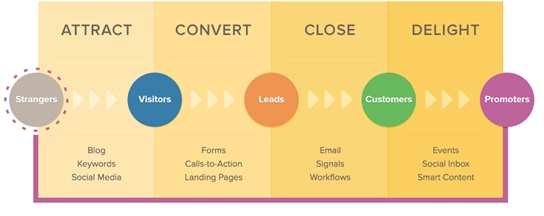
Figure 2: Inbound Marketing Process
Now that we are clear about the complete Inbound Marketing approach here is how inbound can lead your company to new heights.
1. Inbound Marketing Offers The Highest ROI By Far
According to HubSpot’s State of Inbound 2018 Global Results, 53% of marketers achieve a higher ROI on inbound marketing, followed by 16% that manage to do so through outbound marketing. The rest could not measure their ROI (18%) or did not know about or use either marketing strategy (13%). The high ROI is achieved based on several fronts.
- First, inbound marketing is less expensive than outbound marketing.
- Secondly, inbound marketing is more impactful because you approach people that are interested in what you have to offer.
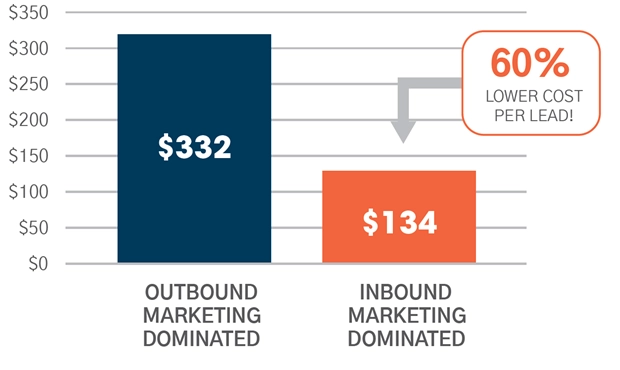
Figure 3: Average Cost per Lead
Setting up a website and then blogging or using social media to attract visitors is less expensive than traditional advertising using TV, radio or even sending direct mail that may never be opened or that may be easily ignored. Additionally, it is a lot more difficult to measure or track the impact of outbound marketing than inbound marketing.
2. Visibility. Be Seen And Heard At Little To No Cost
B2B competition is stiff in almost every industry. Every B2B marketer, whether from a large enterprise or a sole proprietorship, wants a piece of the pie no matter the industry you are in. Therefore, ensuring that your brand is visible is probably the most important thing that you can do because it allows you to present your brand as a viable option.
Inbound marketing creates visibility for brands through content creation that shows up in search engine results. It then provides visitors with answers to questions and concerns that they may have. If you produce high-quality content and distribute the content across different channels, you will become more visible. The best part is that becoming visible can be organic, meaning that you don’t need a huge marketing budget to be seen and heard.
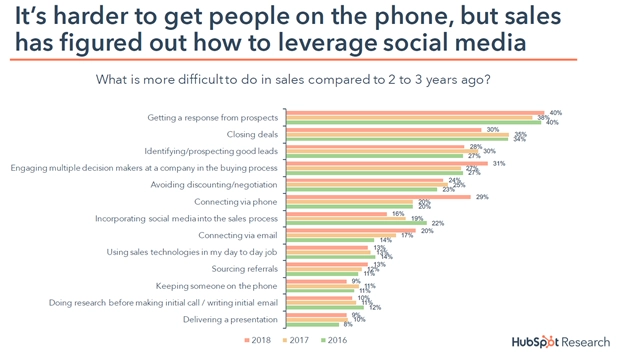
Figure 4: Inbound Methods make it easier to reach Strangers and Leads
3. Reach Targeted People At The Right Time
With inbound marketing, only people that have an interest in whatever you have to offer will interact with your brand. Inherently, inbound attracts people that find and consume your content because they want to know more about what you have to offer or because you can educate them about what they need to know.
If your content catches a stranger’s attention and is compelling enough to keep their interest and provide them with what they are curious to find out, then the visitor is likely to become a lead, and then a customer. In fact, 70% of customers say that contextualized engagement or seamless hand offs based on prior interaction is critical to winning them over.
Furthermore, if you seamlessly and consistently nurture your customers, they will begin to do your work for you, at no cost, just because they love what you have to offer and they want everyone in their circles to know about it as well.
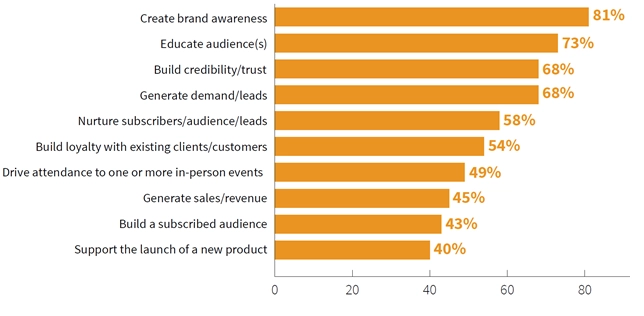
Figure 5: What B2B marketers have achieved through content marketing in 2018
4. Lead Targeting
Essentially, inbound marketing allows the marketer to sort out the different kinds of leads according to the stage of the buying process they are in, or according to the type of interest they express for the product or brand. In fact, the 2019 B2B Content Marketing Institute Report, has found that 77% of top performing brands use personas for content marketing purposes.
By segmenting the leads in this way, the marketer can focus or prioritize efforts towards each group and therefore have a more engaging interaction that will lead towards building a stronger relationship based on trust. With trust, making the sale becomes a lot easier to close. The primary goal is to create high-quality content that appeals to each segment and to eliminate any content that is likely to attract the wrong people that will never make a purchase.
5. Automate Relationship Building
When marketers hear about building trust, most think of the long and difficult path ahead and the many face-to-face meetings or phone conversations that will be made. It doesn’t have to be this way. Many tools can be used to effectively and efficiently automate this process. The end result is that you will not only end up building trust organically without much effort (besides initially setting up the automation system), but you will reach more people more effectively.
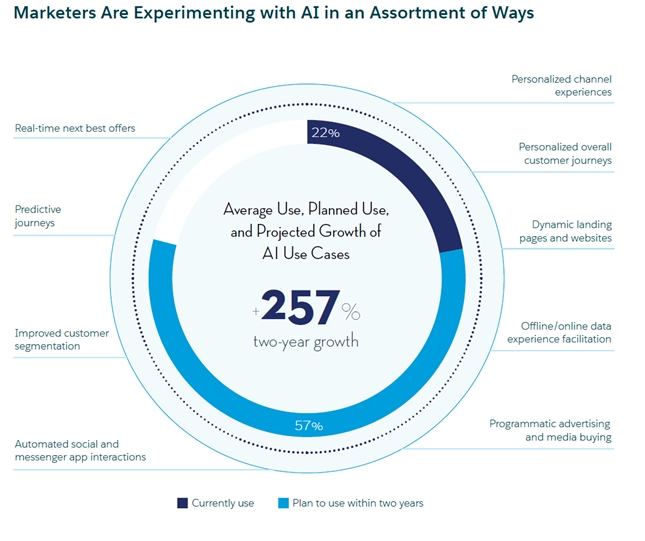
Figure 6: Marketers use AI and automation with Inbound marketing
Most B2B buyers take their time to research and find out about available options of brands that will best meet their needs before they ever think of contacting a sales rep. All along, they are gauging what they feel about the brand and how they are being treated.
95% of B2B customers are loyal to a company they trust. Therefore, if the B2B buyer is given the attention they need in the right doses, then closing the deal almost becomes a formality because affinity, trust and confidence have been built. Automating the relationship mostly involves responding or reaching out to a lead based on trigger events.
6. Build On The Trust, Credibility And Authenticity With Thought Leadership
Effective Inbound marketing is arguably about generating content that builds on trust, authenticity and credibility for your brand or product, not just among your potential customers but also among competitors in your industry. Content can help a company become a thought leader or an authority which translates the message that the brand has relevant experience and is ready and able to help.
The Bottom-Line
Inbound marketing is profitable for business because it is:
- Accountable: every aspect of inbound has a metric that can be measured and improved upon.
- Agile: it’s easy to develop and test new strategies on the fly
- Cost-effective: Its easier to concentrate efforts on areas that produce the most benefit.
- Scalable: Once a brand discovers a working inbound strategy, reaching more people across markets and with changing conditions is seamless and inexpensive
- Customer-centric: Inbound is a natural approach to attract and retain customers
- Integrated: MarTech like CRMs and marketing automation are bringing together sales and marketing to optimise lead generation and the sales process
- Measurable: Every interaction and engagement can be measured and optimized.
All the points highlighted above lead to the fact that inbound marketing can lead to massive benefits for a brand. If you take your time to understand each stage of the inbound marketing approach, including the appropriate tools to use for your specific situation, then your business will quickly soar to great new heights.
Our blog
Latest blog posts
Tool and strategies modern teams need to help their companies grow.

B2B companies must generate leads that are ready to buy their products in order to me...

In the absence of a constant flow of leads, sales teams can't meet their targets and ...

Podcasts and webinars are powerful tools that marketers can use to reach new audience...



